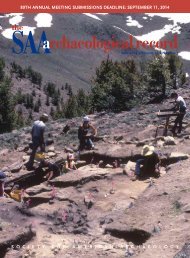SAA
Nov2016_web
Nov2016_web
Create successful ePaper yourself
Turn your PDF publications into a flip-book with our unique Google optimized e-Paper software.
VIDEO GAMES AND ARCHAEOLOGY<br />
Figure 4. Use of light orbs to in Everybody’s Gone to the Rapture.<br />
relatively straightforward task to process LiDAR data with<br />
geographic information systems (GIS) and export the data in<br />
a format accessible by the software used to create video<br />
games (typically referred to as a game engine). The use of<br />
geospatial data supports a more accurate world upon which<br />
to place structures, roadways, and other features of the built<br />
environment. In addition, a massive update to the structures<br />
is designed to increase the virtual world’s realism. Figure 3<br />
compares a structure from the original version of this virtual<br />
world with an updated version. This and other structures are<br />
based on the documentation of nearby, contemporaneous<br />
structures. Studying the historical architecture of northcentral<br />
Florida is necessary to create as accurate a version of<br />
Rosewood as possible. Finally, new 3D models that more<br />
accurately re-create the region’s vegetation are being created<br />
and incorporated into the updated virtual world as well.<br />
Engaging with walking simulators is particularly useful as it<br />
guides the creation of new interactive features within the virtual<br />
world. Relevant examples include the recent game Everybody’s<br />
Gone to the Rapture, by indie developer The Chinese<br />
Room. This game is a good example of how walking simulators<br />
can connect players with the experiences of others in<br />
sensitive and emotionally evocative ways. The game is set in<br />
the fictional village of Yaughton, a picturesque rural location<br />
seemingly devoid of life. The goal of the game is less about<br />
learning what happened and instead about uncovering the<br />
everyday lives of the inhabitants prior to their disappearance.<br />
Everybody’s Gone to the Rapture utilizes a simple, yet visually<br />
appealing device for players to interact with the vanished<br />
inhabitants. Small balls of light materialize as one moves<br />
through the landscape. Upon closer inspection these orbs<br />
coalesce into humanoid shapes (Figure 4), and the sound of<br />
the game changes to accommodate the voices of the vanished.<br />
Sound, typically an underutilized element in games, is<br />
one of the primary characteristics of this game. The entire<br />
tone of the game changes as the balls of light form human<br />
shapes. Once formed, the player begins to hear the final<br />
experiences of the town’s inhabitants. The haunting quality<br />
of this approach creates a deeply emotional atmosphere and<br />
connects the player to the lives of the town’s inhabitants in<br />
evocative ways.<br />
This is similar to the use of “witness points” in the Holocaust<br />
Memorial Museum in Second Life (González-Tennant<br />
2013:72–74). These witness points allow visitors to listen to<br />
the oral histories of Holocaust survivors in a virtual museum<br />
interpreting Kristallnacht. Ongoing updates to the Rosewood<br />
26 The <strong>SAA</strong> Archaeological Record • November 2016




